| Image Soon |
Lemon
Grass (Cymbopogon citratus) |
| Image Soon |
Rocambole
(Allium scorodoprasum) A prized culinary herb! A perennial with
unusual twisted stems and edible aerial bulblets. All
parts of this plant produce a mild garlic flavor
- Culinary:
A mild garlic flavor gives this onion related
herb its popularity. Used frequently in French
and Italian cooking. The flowers develp edible
bulbs.
- Medicinal:
Contains iron and vitamins. A mild antibiotic.
Like all Alliums, it contains sulphur oil which
helps lower blood pressure.
|
| Image Soon |
Rosemary
(Rosmarinus officinalis) Rosemary is an attractive evergreen shrub
with elongated leaves. Praised in the past for the powers
it was thought to posess, and was closely related to the
church.
- Culinary:
Roasted poultry, fish, and meats are great with
the addition of rosemary. A minty pine taste
enhances all kinds of vegetables. Marinades,
vinegars, dressings and sauces.
- Medicinal:
The oil derived from the flowers and foliage is
considered a carminative. Used in pharmacies
today. The oil is also thought to help with pain,
bruises, wounds, and soars when gently massaged
into the wounded areas. Also has some
antibacterial effects to help in the fight
against germs.
- Aromatic:
The minty pine scent is very distinctive. Baths
are drawn with rosemary to help lift the spirits
and relax the body. Rosemary in clothes drawers
is said to deter moths and scent the clothes. Oil
is added to soaps, creams, and perfumes for its
pine scent.
- Ornamental:
Evergreen lance-shaped foliage gives a handsome
effect to the plant. Blue flowers decorate the
plant throughout the summer. Popular in many
gardens.
- Full Sun
- 4-6 feet in height.
- Frozen rosemary is
stronger than fresh rosemary.
- Tender perennial.
- Well-Drained soil.
|
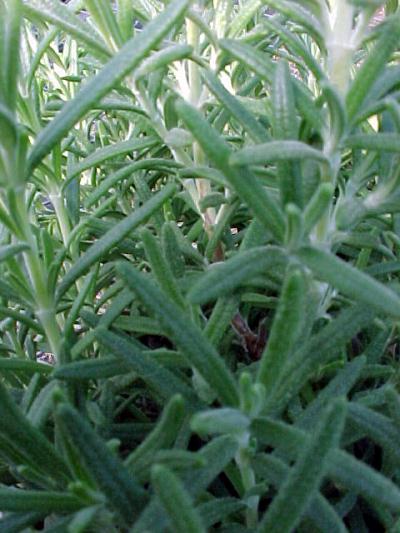 |
Rosemary, Arp (Rosmarinus
officinalis) Not
very different from the straight rosemary. Maybe a bit
thinner foliage with a hint of grey. Mainly the same
habits and uses, yet found in a cold temperate zone, and
thought of as the hardiest of all rosemary.
- Culinary:
Roasted poultry, fish, and meats are great with
the addition of rosemary. A minty pine taste
enhances all kinds of vegetables. Marinades,
vinegars, dressings and sauces.
- Medicinal:
The oil derived from the flowers and foliage is
considered a carminative. Used in pharmacies
today. The oil is also thought to help with pain,
bruises, wounds, and soars when gently massaged
into the wounded areas. Also has some
antibacterial effects to help in the fight
against germs.
- Aromatic:
The minty pine scent is very distinctive. Baths
are drawn with rosemary to help lift the spirits
and relax the body. Rosemary in clothes drawers
is said to deter moths and scent the clothes. Oil
is added to soaps, creams, and perfumes for its
pine scent.
- Ornamental:
Evergreen lance-shaped foliage gives a handsome
effect to the plant. Blue flowers decorate the
plant throughout the summer. Popular in many
gardens.
- Full Sun
- 4-6 feet in height.
- Rosemary does not
transplant well.
- Tender perennial
- Well-Drained soil.
|
| Image Soon |
Rosemary,
Creeping (Rosmarinus officinalis 'Prostratus')
Rosemary was thrown into
caskets of the dead, and hung in sick rooms. The smell
was thought to ward of evil spirits. Also very popular in
the churches. The smell is to never be forgotten.
- Culinary:
Roasted poultry, fish, and meats are great with
the addition of rosemary. A minty pine taste
enhances all kinds of vegetables. Marinades,
vinegars, dressings and sauces.
- Medicinal:
The oil derived from the flowers and foliage is
considered a carminative. Used in pharmacies
today. The oil is also thought to help with pain,
bruises, wounds, and soars when gently massaged
into the wounded areas. Also has some
antibacterial effects to help in the fight
against germs.
- Aromatic:
The minty pine scent is very distinctive. Baths
are drawn with rosemary to help lift the spirits
and relax the body. Rosemary in clothes drawers
is said to deter moths and scent the clothes. Oil
is added to soaps, creams, and perfumes for its
pine scent.
- Ornamental:
Evergreen lance-shaped foliage gives a handsome
effect to the plant. Blue flowers decorate the
plant throughout the summer. Popular in many
gardens. Looks great in hanging baskets, with
flowering branches hanging over the edge.
- Full Sun
- Creeper.
- Grow rosemary from
cuttings, seeds do not germinate well.
- Tender perennial
- Well-Drained soil.
|
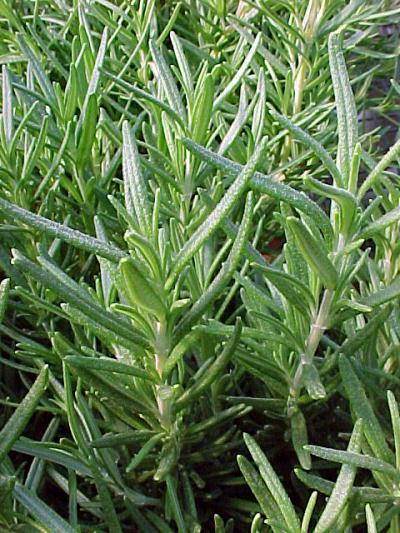 |
Rosemary,
Foresteri (Rosmarinus officinalis 'Foresteri')
Rosemary's past shows this
plant to be quite holy. Carried by people hiding from the
black plague, it was thought to ward off disease and
sickness. It was burned to purify the air in sick
chambers.
- Culinary:
Roasted poultry, fish, and meats are great with
the addition of rosemary. A minty pine taste
enhances all kinds of vegetables. Marinades,
vinegars, dressings and sauces.
- Medicinal:
The oil derived from the flowers and foliage is
considered a carminative. Used in pharmacies
today. The oil is also thought to help with pain,
bruises, wounds, and soars when gently massaged
into the wounded areas. Also has some
antibacterial effects to help in the fight
against germs.
- Aromatic:
The minty pine scent is very distinctive. Baths
are drawn with rosemary to help lift the spirits
and relax the body. Rosemary in clothes drawers
is said to deter moths and scent the clothes. Oil
is added to soaps, creams, and perfumes for its
pine scent.
- Ornamental:
Evergreen lance-shaped foliage gives a handsome
effect to the plant. A deeper green to the
foliage, and a bit more of a shine, than other
species of rosemary.
- Full Sun
- 3-6 feet in height.
- Makes an excellent
border plant. Easily trained.
- Tender perennial
- Well-Drained soil
|
| Image Soon |
Rosemary, Pink
(Rosmarinus officinalis 'Rosea') All the same properties as other upright
rosemary's, but a difference in color. Pink rosemary is
for those who prefer the difference from the other
rosemary's. Great for the perennial garden.
- Culinary:
Roasted poultry, fish, and meats are great with
the addition of rosemary. A minty pine taste
enhances all kinds of vegetables. Marinades,
vinegars, dressings and sauces.
- Medicinal:
The oil derived from the flowers and foliage is
considered a carminative. Used in pharmacies
today. The oil is also thought to help with pain,
bruises, wounds, and soars when gently massaged
into the wounded areas. Also has some
antibacterial effects to help in the fight
against germs.
- Aromatic:
The minty pine scent is very distinctive. Baths
are drawn with rosemary to help lift the spirits
and relax the body. Rosemary in clothes drawers
is said to deter moths and scent the clothes. Oil
is added to soaps, creams, and perfumes for its
pine scent.
- Ornamental:
Evergreen lance-shaped foliage gives a handsome
effect to the plant. Pink flowers decorate the
tops of this plant almost continuously throughout
the summer.
- Full Sun
- 3-6 feet in height.
- Gather most of your
rosemary stock just before flowering.
- Tender perennial
- Well-Drained soil.
|
| Image Soon |
Rosemary, Primly
Blue (Rosmarinus officinalis 'Primly Blue') |
| Image Soon |
Rosemary, Tuscan
Blue (Rosmarinus officinalis 'Tuscan Blue')
Larger foliage and faster
growth is what gives this species an edge over others. A
deep green color adds more of an interest to Tuscan Blue,
and it prctically grows straight upwards.
- Culinary:
Roasted poultry, fish, and meats are great with
the addition of rosemary. A minty pine taste
enhances all kinds of vegetables. Marinades,
vinegars, dressings and sauces.
- Medicinal:
The oil derived from the flowers and foliage is
considered a carminative. Used in pharmacies
today. The oil is also thought to help with pain,
bruises, wounds, and soars when gently massaged
into the wounded areas. Also has some
antibacterial effects to help in the fight
against germs.
- Aromatic:
The minty pine scent is very distinctive. Baths
are drawn with rosemary to help lift the spirits
and relax the body. Rosemary in clothes drawers
is said to deter moths and scent the clothes. Oil
is added to soaps, creams, and perfumes for its
pine scent.
- Ornamental:
Evergreen lance-shaped foliage gives a handsome
effect to the plant. Blue flowers decorate the
tops of this plant almost continuously throughout
the summer. Also known to be a bit taller than
the other species of rosemary.
- Full sun
- 5-7 feet in height.
- Wet soil promotes
root rot. Well drainage in essential.
- Tender perennial
- Well-Drained soil.
|
| Image Soon |
Rosemary, White
(Rosmarinus officinalis 'Alba') Another upright rosemary that holds it's
place in the garden for the white flowers it produces.
Mainly chosen over others for the buyers preference in
the color of flower. Just as attractive.
- Culinary:
Roasted poultry, fish, and meats are great with
the addition of rosemary. A minty pine taste
enhances all kinds of vegetables. Marinades,
vinegars, dressings and sauces.
- Medicinal:
The oil derived from the flowers and foliage is
considered a carminative. Used in pharmacies
today. The oil is also thought to help with pain,
bruises, wounds, and soars when gently massaged
into the wounded areas. Also has some
antibacterial effects to help in the fight
against germs.
- Aromatic:
The minty pine scent is very distinctive. Baths
are drawn with rosemary to help lift the spirits
and relax the body. Rosemary in clothes drawers
is said to deter moths and scent the clothes. Oil
is added to soaps, creams, and perfumes for its
pine scent.
- Ornamental:
Evergreen lance-shaped foliage gives a handsome
effect to the plant. White flowers decorate the
tops of this plant almost continuously throughout
the summer. Foliage is a bit thinner and lighter
than the other species.
- Full Sun
- 3-6 feet in height.
- Makes a great indoor
container plant.
- Tender perennial
- Well-Drained soil.
|
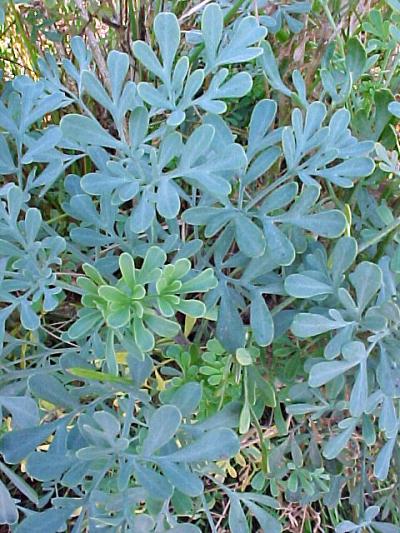 |
Rue (Ruta graveolens) This small
evergreen shrub plant is also known as the herb of grace.
It takes well to poor garden soil where it makes a
compact and attractive plant. The scent is somewhat
unique, and unpleasant to some. The shape of the leaf is
what the suit of clubs resembles.
- Medicinal:
In the past, Rue was believed to relieve
gas pains, and improved appetite. However, there
are no studies to prove these effects, and it is
wideley thought of as toxic. Caution to large
doses.
- Ornamental:
The blue-green foliage to the plant, and the
round lobed foliage are what this plant is mostly
grown for. Also, Yellow flowers from June to
August.
- Full
Sun
- 36
inches in height.
- Contact
to sensitive skin might cause blistering.
- Perennial.
Evergreen
- Well-Drained.
|
| Image Soon |
Sage, Berggarten
(Salvia officinalis 'Berggarten') A selection from Germany featuring
broad rounded leaves and a compact growth habit. An
attractive ornamental addition to the herb or even
perennial garden.
- Culinary:
Foliage is eaten fresh in salads, and cooked into
many types of foods. bread products, soups, meat
pies, maetloaf, marinades, and stuffings. Goes
great with vegetables
- Ornamental: Soft
and fuzzy greyish leaves make this plant
striking. Rounded foliage is compared to the
elongated foliage of other species. blue flowers.
- Full sun to part
shade.
- 16-20 inches in
height.
- Prune Sage plants
severely in the Spring. To demote seeding
- Perennial.
- Well-Drained and rich
soil.
|
| Image Soon |
Sage, Garden
(Salvia
officinalis) Garden Sage is a decorative evergreen shrub
with downy green foliage. Being the original of the
Sages. In ancient times, it was called the herb of
longevity. Yugoslavia still plants fields of sage for
consumption.
- Culinary:
Flowers may be used in salads, and
brewed for a tea. Foliage is cooked with meats,
and goes great in stuffing.
- Medicinal:
Sage helps in digestion. Tea helps with
coughs and colds. Also helps with diarrhea.
- Aromatic:
Sage is used in perfumes, and cosmetics. Even
some soaps. The smell of the foliage repels
flies, and some other insects.
- Full sun.
- 32 inches in height.
- Dried Sage has a
stronger, yet different flavor.
- Perennial
- Dry, Well-Drained
soil.
|
| Image Soon |
Sage, Gold
(Salvia officinalis 'Aurea') A golden contrast of Sage is what everyone
need in their garden. With all of the same qualities of
the Garden Sage, but with a pleasing addition for the
eye. A marvelous plant.
- Culinary:
Foliage is eaten fresh in salads, and cooked into
many types of foods. bread products, soups, meat
pies, maetloaf, marinades, and stuffings. Goes
great with vegetables.
- Medicinal:
Tea made from the leaf is an antiseptic and helps
with the blood and the nerves.
- Aromatic: Foliage
is aromatic with a strong scent. The scent of
Sage may be recognized when drifting through the
air.
- Ornamental:
Striking green and gold foliage please the eye.
The gold borders the leaf with a large band. The
compact foliage makes this a nice border plant.
- Full Sun
- 18 inches in height.
- Historically, Sage
does not grow too well next to onions.
- Perennial
- Well-Drained Soil
|
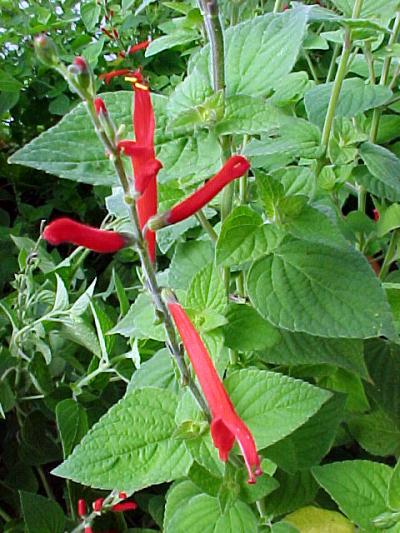 |
Sage, Honeymelon
(Salvia elegans 'Honeymelon') More of an upright grower, this Sage is
somewhat different from most of the other sages. The
height, and the beauty of the brilliant red flowers, make
this Sage and attractive bush-like plant.
- Culinary:
- Ornamental: The
scarlet red flowers are a major attractions to
butterflies, and hummingbirds. Heart-shaped
leaves. Cut flowers are great in vases or as a
garnish.
- Aromatic:
The scent of the honey dew melon is a delicious
addition the the plants qualities. A must smell.
- Full Sun
- 24 inches in height.
- Keep from cold.
- Tender perennial
- Well-Drained soil
|
| Image Soon |
Sage, Pineapple
(Salvia elegans) A
close relative of the Honeymelon Sage, but a bit larger
and a different scent. Elongated leaves with a fine point
also helps differ the two. this plant will get your mouth
watering. Pineapple Sage also makes a wonderfull indoor
plant.
- Culinary: ?
- Ornamental: Beautiful
red flowers from late-summer to fall give this
plant remarkeable ornamental values. Nicely
pointed leaves, and a bush-like shape to the
plant make it nice in the house. Even without the
flowers.
- Aromatic:
Delicious pineapple flavored aroma will fill the
air if walked by or brushed upon.
- Full Sun
- 36 inches in height.
- Keep from cold.
- Tender Perennial
- Well-Drained soil.
|
| Image Soon |
Sage, Purple
(Salvia officinalis 'Purpurea') A compact form of officinalis. This herb has
the same habits as the Gold Sage and is just as
attractive. Leather-like foliage makes most sages
familiar to the eye.
- Culinary:
Foliage is eaten fresh in salads, and cooked into
many types of foods. bread products, soups, meat
pies, maetloaf, marinades, and stuffings. Goes
great with vegetables.
- Medicinal:
Tea made from the leaf is an antiseptic and helps
with the blood and the nerves.
- Aromatic: Foliage
is aromatic with a strong scent. The scent of
Sage may be recognized when drifting through the
air.
- Ornamental: Purple
foliage and a compact, dense growth habit makes
this a great border plant.
- Full Sun
- 18 inches in height.
- Sage and Rosemary are
great companions.
- Perennial
- Well-Drained Soil.
|
| Image Soon |
Sage, Russian
(Perovskia atriplicifolia) Mostly known for its ornamental values as a
perennial plant. The unique aromatic and ornamental
features of this plant make it an interest to all. 1995
Perennial Plant of the Year.
- Aromatic: A
characteristic scent to the foliage is quite
intriguing. Bruise the foliage and it increases
in scent.
- Ornamental:
Grey-green foliage topped with masses of striking
blue elongated flower spikes makes this plant a
popular veteran to many gardens.
- Full Sun
- 36-48 inches in
height.
- Cut back when the
plant begins to look unpleasing to the eye.
- Perennial
- Well-Drained Soil
|
| Image Soon |
Sage, Tri-Color
(Salvia officinalis 'Tri-Color') Keeping up with the other colored sages(gold
and purple), Tri-Color Sage is also very striking in
appearance. Not just one or two colors, but, of course
three. Not as compact or dense in growth.
- Culinary:
Foliage is eaten fresh in salads, and cooked into
many types of foods. bread products, soups, meat
pies, maetloaf, marinades, and stuffings. Goes
great with vegetables.
- Medicinal:
Tea made from the leaf is an antiseptic and helps
with the blood and the nerves.
- Aromatic: Foliage
is aromatic with a strong scent. The scent of
Sage is characteristic, and may easily be
recognized when drifting through the air.
- Ornamental:
A very decorative herb with the cream colored
variegation along with purple and green.
- Full Sun
- 24-36 inches in
height.
- Cut back after
flowering
- Perennial
- Well-drained Soil.
|
| Image Soon |
Salad Burnet
(Poterium sanguisorba) This forgotten herb used to be highly
preferred for a taste of cucumber in your salad. The
Sixteenth Century popularized this herb as bieng high in
medicinal value.The herb has dissapeared from the uses in
which it was once generously used.
- Culinary:
The foliage has the taste of cucumbers, but the
older leaves are bitter in taste, so stick to the
young foliage.Salads and coleslaw are the two
biggest uses for the leaves. Also found in some
cheeses and soups.
- Medicinal:
Foliage contains vitamin C, and helps aid in
digestion. Once thought to heal wounds by
bringing the two sides of the cut together and
sealing it. Used to relieve hemmorhoids and
diarrhea.
- Ornamental:
Small green flowers with red tips appear in
mid-summer. The foliage suggests this herb as a
nice edging plant.
- Full Sun to part
shade.
- 12-24 inches in
height.
- Burnet does not dry
well. It will lose it's taste.
- Perennial
- Well-Drained soil
|
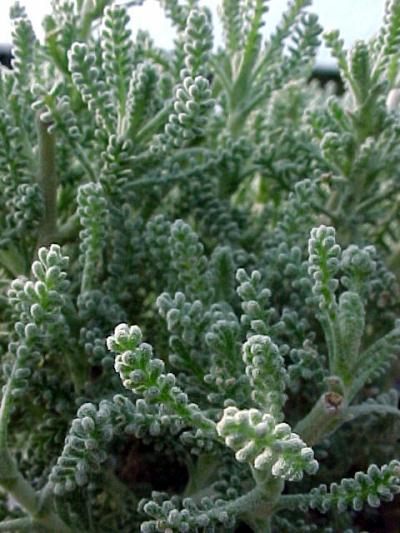 |
Santolina,
Compactum (Santolina chamaecyparissus) A smaller and tighter version of
Grey Santolina. More valuable in ways for it's compact
habit. Originating in the Mediterranean. Medicinal in the
past, but presently Ornamental.
- Aromatic:
The foliage is added to potpourri for the musky
scent it emits. Foliage deters insects.
- Ornamental:
Silverish, fern-like foliage makes this plant
fantastic for borders. Neatly trimmed. Bright
yellow buttons top the feathery foliage in June
and July.
- Full Sun
- 12-24 inches in
height.
- Do not take
internally.
- Perennial
- Well-Drained soil.
|
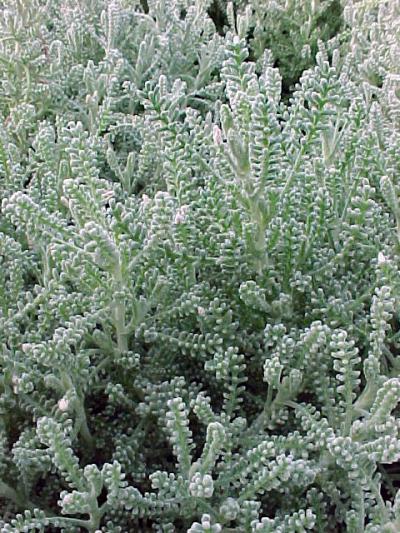 |
Santolina, Grey
(Santolina chamaecyparissus) Native to the Mediterranean, this herb was
once used for medicinal purposes. Once thought to kill
worms, it is no longer thought of as medicinal, but
highly used for it ornamental properties.
- Aromatic:
The foliage is added to potpourri for the musky
scent it emits. Foliage deters insects.
- Ornamental:
Silverish, fern-like foliage makes this plant
fantastic for borders. Neatly trimmed. Bright
yellow buttons top the feathery foliage in June
and July.
- Full Sun
- 18-24 inches in
height.
- Do not take
internally.
- Perennial
- Well-Drained soil.
|
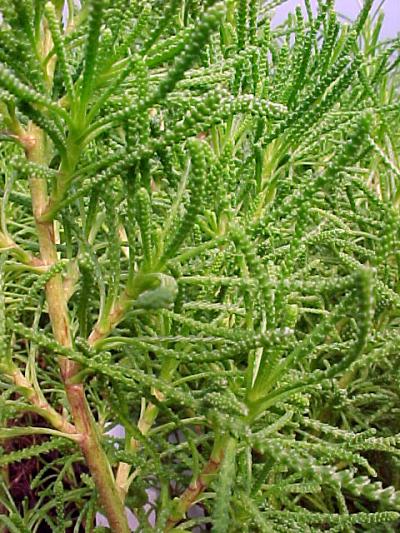 |
Santolina, Green
(Santolina virens) Practically
identical to the Grey Santolina, but with green foliage.
Used to sweeten the air in Mediterranean regions for
ages. Makes a great border plant, and was famous in the
past for its use in knot gardens.
- Aromatic:
The foliage is addd to potpourri for the musky
scent it emits. Foliage deters insects, and
sprigs are used in clothes drawers for moths.
- Ornamental:
Silverish, fern-like foliage makes this plant
fantastic for borders. Neatly trimmed. Bright
yellow buttons top the feathery foliage in June
and July.
- Full Sun
- 18-24 inches in
height.
- Do not take
internally.
- Perennial
- Well-Drained soil.
|
| Image Soon |
Savory, Creeping
Winter (Satureja montana 'Repanda') A mat of bright green leaves is
formed by this evergreen subshrub. Used for over 2,000
for its flavor addition to food. At one time, savory was
the highest in flavor for the time it was in. Therefore
it's rise in popularity was easily explained.
- Culinary:
A stronger flavor than it's brother, Summer
Savory. Used with meats, and especially popular
with beans. Flavors vinegars, and may be
sprinkled on soups and stews.
- Medicinal:
Foliage is crushed and added to bites and stings
for temporary pain relief. Tea is used for
diarrhea, appetite problems, and sore throats.
- Full Sun
- 3 inches in height.
- Dried leaves are
available comercially.
- Perennial
- Light, Well-Drained
soil.
|
| Image Soon |
Savory, Summer
(Satureja hortensis) Native to the Mediterranean, it was
much in demand in early Rome where it was thought to be a
powerful aphrodisiac. Almost identical to its brother,
Winter Savory, but a bit milder in taste.
- Culinary:
Meats, beans, and vinegar are major uses for this
herb. used with the majority of vegetables, and
popular in stews.
- Medicinal:
Foliage is crushed and added to bites and stings
for temporary pain relief. Tea is used for
diarrhea, appetite problems, and sore throats.
- Full Sun
- 12-18 inches in
height.
- Dried leaves are
available comercially.
- Annual
- Average soil
|
| Image Soon |
Savory, Winter
(Satureja montana) A
darker and firmer foliage than Summer foliage. Almost
identical in all application except for the hardiness in
the garden. Almost entirely used for their culinary
values today.
- Culinary:
A stronger flavor than it's brother, Summer
Savory. Used with meats, and especially popular
with beans. Flavors vinegars, and may be
sprinkled on soups and stews.
- Medicinal:
Foliage is crushed and added to bites and stings
for temporary pain relief. Tea is used for
diarrhea, appetite problems, and sore throats.
- Full Sun
- 6-12 inches in
height.
- Dried leaves are
available comercially.
- Perennial
- Light, Well-Drained
soil.
|
![]()